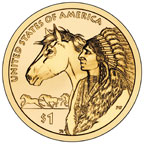Coin of the Month
2012 Native American $1 Coin
This year's Native American $1 Coin is about Native American trading and the pathways through the wilderness that the trading created. At one time, one of the most popular items to trade was the horse, so horses stand for trade on this coin.
The Spanish brought shipments of horses from Spain among their first cargoes. They tried to keep them away from the natives of the New World, but gradually Spanish horses became American Indian horses. Some of the horses escaped into the wild, some were captured in raids, but eventually they spread across the land and changed the lives of Native Americans forever.
The horse's spread began in the West, from the area of Mexico, along Native American trading routes. The Navajo, Ute, and Apache got them from the Pueblo; the Comanche traded their horses to their northern kinsmen, the Shoshone.
By 1700, horses had reached the northwestern tribes like the Bannock, Nez Perce, Cayuse, and Umatilla. To the east, trade routes brought them to the Missouri River tribes and the River and Mountain Crow.
What was a horse worth in a trade? In the early 1800s, you could get a good riding horse for 8 buffalo robes. A fine racing horse, on the other hand, could cost you 10 guns. Trading without money can get very complicated depending on going rates, how badly you want something, and what you have on hand to trade, but generally you could pick up a horse for, say, 3 pounds of tobacco, 15 eagle feathers, 10 weasel skins, or 5 tipi poles.
Why was the horse so popular? Among other reasons:
- Riding a horse was faster than walking.
- A horse could pull a much heavier load than a dog or a person could when it was time to move camp.
- Since a horse could outrun a buffalo, it made hunting easier.
Read more about the network of trade routes this coin honors at the bottom of the Native American $1 Coins page.
—Nero



Content Related Link


